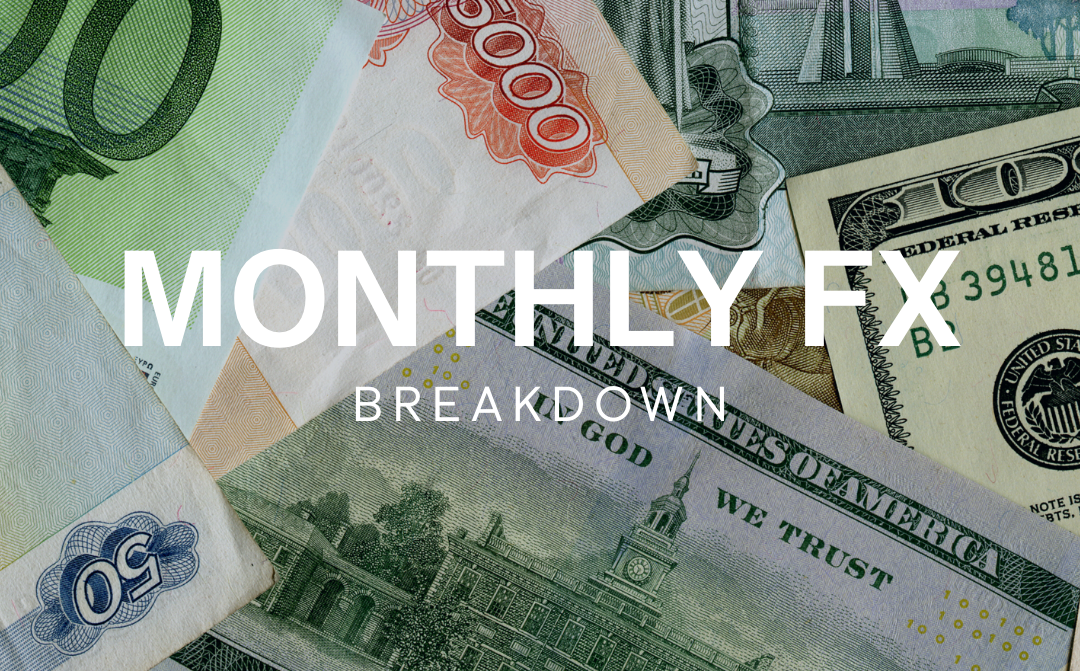Monthly FX Breakdown – October 2023

Table of Content
USD
The US dollar has enjoyed a particularly strong September, with concerns around the potential for a market correction helping to lift demand for this haven currency. For the dollar index this has brought about a rise into the highest level since November 2022, ending the month with a eleventh consecutive week of gains. While the US economy does play a key role in USD valuations, the risk-off sentiment permeating throughout financial markets has been a key driver of upside for the greenback.
From an economic perspective, the global shift towards away from rising rates should benefit market sentiment. However, the risk of a second wave for inflation alongside concerns around a Chinese slowdown have done little to help sentiment for equities. The FOMC added to those worries, with a rate pause overshadowed by a hawkish update to the dot plot. That new plot outlined expectations that we will see rates remaining elevated into 2025, with inflation clearly expected to remain an issue.
Keep a close eye out for the FOMC meeting minutes due to for release on 11 October, with market participants looking for any updates to build on the hawkish takeaway from the September meeting. Inflation data will similarly play a key role in dollar sentiment, with a third consecutive increase likely to cause concern if it comes to fruition. With rising energy prices driving consternation over the risk of a second inflation wave, keep a close eye out for WTI which looks likely to be increasingly correlated with the USD as traders shift into risk-off mode on any fresh surge for energy prices. Also watch out for a potential government shutdown starting at the beginning of October, with Joe Biden thus far unable to find agreement with the Republicans who seek to drastically cut back democrat spending.
EUR
The euro experienced a strong start to September, but ultimately lost ground against many of its peers in the wake of a dovish hike from the ECB. The strength seen for European currencies appears to have faded over the past month, although the euro did manage to outperform its UK neighbours. With inflation falling and the ECB indicating the end of their tightening cycle, traders are much less confident to back this currency at a time of economic concern.
September saw the euro suffer against havens and commodity currencies alike, with tentative signs of improvement in China helping to lift AUD and NZD against their European counterparts. Whilst the initial reaction to a 25-basis point hike from the ECB was one of euro strength, their dovish outlook soon brought the single currency back down to earth. PMI data did see some improvement for the German services sector, but the wider picture remains a fractious one that will keep pressure on the ECB to hold off on any additional tightening for now.
Looking ahead, inflation and growth data will continue to be viewed through the prism of ECB action, with any further deterioration in PMI or jobs data likely to drive EUR lower. The tone of the ECB meeting points towards a rate pause on 26 October, but the euro will likely remain volatile around the potential for any strengthening of the economy that might allow for further action. With rising energy prices signalling the potential for another price surge, any economic improvements could be deemed a facilitator of additional easing from the ECB.
GBP
The pound has suffered widespread selling over the course of the past month, with GBPUSD and GBPCAD hitting a six-month low. This unravelling of the long GBP trade comes as the Bank of England falls back in line with many of its peers, with the BoE apparently happy to keep rates where they are despite UK inflation being well above their peers. That being said, we have seen that inflation gap close significantly, and markets have reacted with widespread selling off the back of a surprisingly dovish BoE September meeting.
On the economic-front, the latest PMI survey saw a second consecutive sub-50 reading for UK services, highlighting a strong chance that the economy as a whole is beginning to shrink as we head into Q4. With the unemployment rate rising by 0.6% in six months, we are gradually seeing signals of distress in the jobs market. Meanwhile, UK house prices have been moving significantly lower according to the Halifax and Nationwide HPI surveys, with elevated interest rates finally making a tangible impact on affordability. The continued decline in inflation has helped drive much of the GBP weakness of late, with the decline in core CPI proving a welcome surprise. However, the elevated nature of average earnings (8.5%) does spell trouble given the potential to drive continued demand even at these higher prices.
Inflation and earnings data will continue to play an important role in determining sentiment in the UK, with the continued decline in CPI key to driving the pound lower. Sentiment at the BoE signals a willingness to let things play out for the time being, as signs of economic weakness point towards a belated impact of higher interest rates. However, with the Bank of England’s decision to pause having come through such a highly divided 5-4 vote, any signals of economic strength or rising inflation could lift expectations of a rate hike in the coming meetings.
CAD
The Canadian dollar enjoyed a blockbuster month, with rising energy prices helping this commodity currency to gain ground over most of its peers throughout September. The risk-off mood evident in financial markets did little to dent sentiment for a currency that is typically pro-cyclical, with concerns around the Chinese economy doing little to dampen the outlook for crude bulls. Nonetheless, this made for a less reliable month against havens such as the dollar, with CAD faring particularly well against the likes of EUR and GBP.
From a central bank perspective, the Bank of Canada decided to keep rates steady at 5% this month. While this was widely expected, the minutes from this meeting made it clear that the bank could raise rates further and want to dispel any notion that by pausing they will be gearing up for a rate cut. Rising inflation and a negative GDP reading highlighted the ongoing concerns for the BoC, with additional tightening a distinct possibility going forward.
The coming month should bring particular focus on the jobs market, with any further upside for unemployment likely to raise concerns that may push another pause from the BoC. Inflation data will undoubtedly be key, with any further upside bringing renewed pressure to tighten when the bank meets on 25 October. With crude oil prices playing a key role in sentiment for the Canadian dollar, the ongoing push towards the $100 threshold will be crucial for CAD sentiment given concerns over tight supply and resilient demand.
AUD
The Australian dollar has fared relatively well for a currency that has been under pressure for much of this year. However, much of that strength has primarily come against the European currencies, with EUR, GBP, and CHF all providing easy targets for AUD. The mixed nature of its performance is highlighted by the losses seen against the likes of USD, CAD, and NZD.
Concerns around the Chinese economy have been a particular bugbear for AUD bulls, although this month as thankfully provided some periods of calm. The real estate crisis appears to be rumbling on, but September did provide cause of optimism as China ended its period of deflation, and showed improvement across industrial production, retail sales, and export data. In Australia, rising inflation and a relatively robust economy allow for a central bank that is more open to another rate hike than others. That data dependency will be key going into October, with any further upside to inflation bringing potential AUD gains. Conversely, any economic deterioration that might point towards the impact of higher rates finally kicking in would likely further the ‘wait and see’ approach to monetary policy.
NZD
The Kiwi dollar enjoyed a remarkably strong week against many of its counterparts, with only the USD and CAD gaining ground against NZD of the major currencies. Strength against their Australian neighbours highlight the differences between the two economies, with New Zealand’s agricultural exports looking to hold up better as global manufacturing continues to feel the pinch. Meanwhile, the elevated nature of RBNZ rates (5.5%) compared with the RBA (4.1%) bring greater attraction for the New Zealand dollar.
September saw the global dairy trade data improve markedly, with the value of New Zealand’s exports clearly improving according to the latest 4.6% figure. Meanwhile, the New Zealand economy has proved remarkably resilient according to the Q2 GDP reading of 0.9%.
While we have seen the RBNZ keep rates steady, markets continue to price another rate hike in early 2024. The monetary policy decision due on 4 October is widely expected to bring another pause, but the tone could be significantly more hawkish than some of its Western counterparts. Keep a close eye out for the quarterly inflation gauge on 18 October, with any change from the current downward trajectory likely to bring upside for the NZD. In terms of China, further signs of improvements would be most welcome for NZD bulls, lifting expectations for export activity.
Disclaimer: This material is a marketing communication and shall not in any case be construed as an investment advice, investment recommendation or presentation of an investment strategy. The marketing communication is prepared without taking into consideration the individual investors personal circumstances, investment experience or current financial situation. Any information contained therein in regardsto past performance or future forecasts does not constitute a reliable indicator of future performance, as circumstances may change over time. Scope Markets shall not accept any responsibility for any losses of investors due to the use and the content of the abovementioned information. Please note that forex trading and trading in other leveraged products involves a significant level of risk and is not suitable for all investors.







